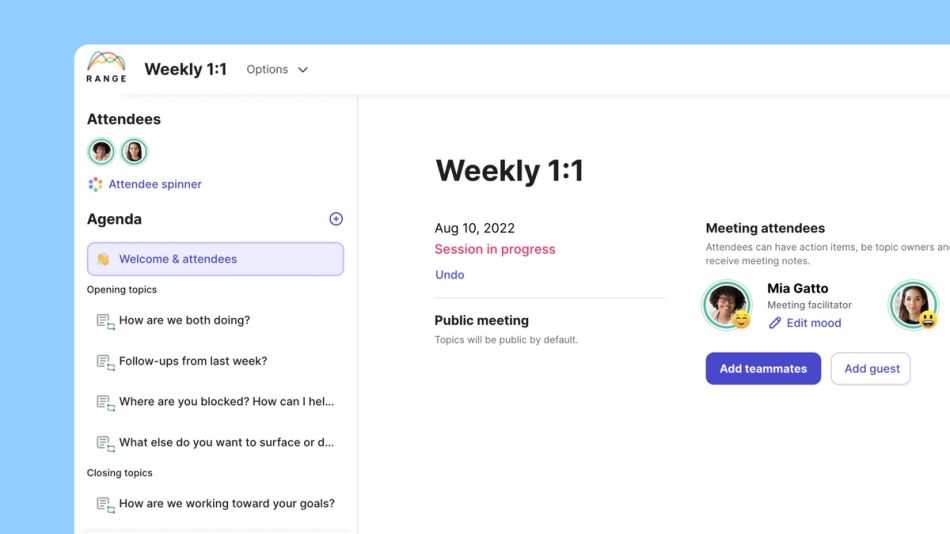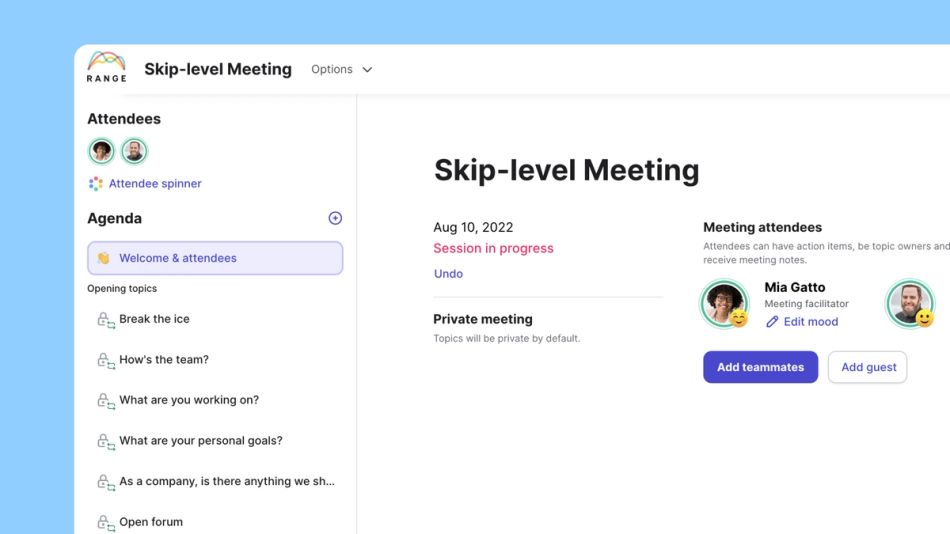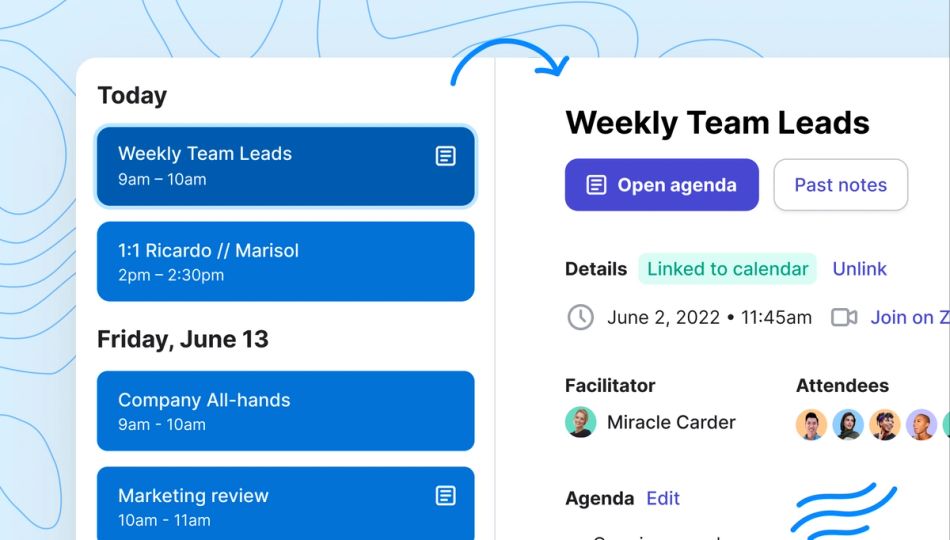As a manager, 1-on-1 meetings with your employees should be a key item in your toolbox.
These meetings are essential for the growth and development of you, your team, and the company as a whole.
When done properly, they identify a myriad of problems before they escalate, and let you work together on an individual basis to correct these things — whether they are habits you want to discourage employees from developing, or overall problems in your workflow that may be impeding progress.
Keep reading to learn more about the value of these meetings. We’ll show you how effective they can be, and how to design 1-on-1s with meeting questions and action items that keep you productive.
The most popular 1-on-1 meeting templates
Range offers three free 1-on-1 meeting templates that you can use as a guide for your own meetings:

- Weekly 1-on-1: This template is a great baseline that lets you create a weekly routine of check-ins with your employees. It’ll help both of you stay in the loop, resolve problems, and keep discussions productive.

- Lara Hogan First 1-on-1: This meeting template was developed by Laura herself — an author, speaker, and coach to tech industry managers. This template gives you a guide to that very first 1-on-1 with a new employee so that you can set just the right tone.

- Skip level 1-on-1: An optimal meeting template for senior managers, VPs, and CEOs. It’s ideal for meeting with people who aren’t your direct reports. This template guides you through the process so that you get more visibility into day-to-day activities in a comfortable setting for both you and the employee.
⭐️ Build your agenda & share great meeting notes
⚡️Choose the Range meeting template that's right for you
Personalize your template with additional questions
Recurring 1-on-1 meetings are crucial to keeping teams working smoothly. They’re a place to identify problems and find their solutions.
They also help you build a rapport with each team member, giving both of you a forum in which to communicate — and perhaps more importantly, learn how to best communicate with each other.
It's all part of building great relationships. Once you’ve formed those relationships, you and your team will work together like a well-oiled machine, achieving goals and celebrating successes.
The templates that Range offers are all customizable.
Make your recurring 1-on-1s in your own style so that they’re as effective as possible.
Need some ideas? We included some sample questions that you can include, or tweak to make your own.
General 1-1 questions
These are the basics. They let you express concern, show that you care, and get the meeting off to a productive start by getting right to the point:
- How are things going? (This can be personal, professional, or both)
- Is anything specific on your mind this week?
- Do you have questions for administrators?
- Is there anything from last week’s meeting that you’d like to continue discussing?

Alignment 1-1 questions
Use these questions to steer the conversation in a productive direction, or to start a new discussion:
- Do you understand the team’s goals and how they relate to the company’s goals? Are you confident in the company’s current direction? Why or why not?
- Would you like to ask questions about our strategy?
- Do you need input from me on anything?
- Are there resources you need access to?
Progress 1-1 questions
These questions are designed to gauge progress, learn more about goals achieved (and yet to be achieved), and any challenges or new information encountered along the way:
- What key achievements have you made since our last meeting?
- How is progress going on your goals?
- Have you had any roadblocks? Where’s the best place to start on a solution to these issues?
- Can you tell me something new you’ve learned since our last talk?
- Are there any challenges that you’ve faced since we last talked?
- Can you tell me some things that have gone well since the last meeting?
Relationship-building 1-1 questions
Use these questions to build trust and to solidify relationships with your team members:
- Do you have any feedback for me or ways that I can improve?
- Is there something more we could be doing at these meetings that would be beneficial?
- Are there any interactions with me or someone else that you’d like to bring up?
- What are things I can do to support you between now and our next meeting?
Aspirational 1-1 questions
These questions will help you help employees build skills and achieve career goals:
- How is progress going on your career goals?
- Are there any skills that you’d like to work on more?
- Is there anything I can do to help you with career development?
Next step 1-1 questions
Last, these questions set the pace for the days ahead of your next meeting — and they’ll help set the agenda for your next meeting, too:
- What are your top priorities over the next few days?
- What things should we put on the agenda for discussion next week?
The art of a fruitful 1-on-1 meeting agenda
Do it well, and 1-on-1 meetings might just become a favorite among your employees. When great managers give employees a private space to express themselves safely, it can do wonders — you never know what talking points they would like to bring to the table. It’s a process that builds trust, rapport, and employee engagement.
Unlike the stereotypical performance review (which has a pretty bad reputation), these 1-on-1 meetings should help employees feel valued and supported.
Research by Gallup highlights why this type of meeting is becoming so important. They report that 59% of millennials, who currently make up the majority of the workforce, prioritize opportunities to learn and grow when they apply to new jobs.
This contrasts sharply with Gen X, of whom only 44% say the same thing. Only 41% of Baby Boomers report that growth and development opportunities were important to them. How do these statistics tie into 1-on-1 meetings?
The value of one-on-ones
- As part of a holistic management system that seeks to improve everyone’s experience so that as a team, one-on-ones make you better equipped to pursue your goals. They’re rife with opportunities for growth and development for everyone involved.
- One-on-one meetings are also a valuable way to build and strengthen team culture. Often, people view a good culture as a “perk” — not something that is inherently necessary, but something that is nice to have. The truth is that a great team culture is absolutely essential. Without it, you risk managing a toxic work environment. When environments are toxic, productivity declines, errors abound, and morale plummets. While it may seem like team culture is created through team activities, you may be surprised to learn that team culture starts on the individual level.
- Find out what your team’s pain points are and learn how you can foster an environment where everyone can thrive. Remember: A rising tide lifts all boats.
Building a culture that employees are proud to be a part of all starts with 1-on-1 meetings. Now let’s learn how to design them. Below, we’ll discuss some of the most valuable discussion topics you can focus on during these meetings.
Valuable discussion topics for 1-on-1 meetings
So, what exactly should you talk about during 1-on-1 meetings? It all depends on your team and the type of culture you want to create — plus how often you plan to hold these meetings. Weekly meetings are common, but you can also do daily, bi-weekly, or monthly, too.
Here are a few things to consider for your meeting agenda template:
Open with something informal. Ask about the employee’s family, or talk about their weekend plans.
- Break the ice with something casual, unrelated to work. It can be helpful to take notes during each call so you can ask about relevant personal topics.
- Jump into follow ups from items you discussed at your last meeting. Now is a good time to recap.
- Inquire about any issues that may be getting in the employee’s way so that you can work toward solutions.
- Discuss top priorities to make sure you and your employee are on the same page.
- Talk about ways to elevate the quality of work with a focus on solutions.
- Provide constructive feedback to help the employee improve or let them know where they’re doing great.
- Make sure one of your agenda items is to check in on professional goals and other long-term goals. As a manager, part of your job is to help your employee achieve these goals.
- Ask for feedback — there is always room for all of us to improve.
There are also a couple of subjects you want to avoid during your 1-on-1:
- Status updates: These are better left for team meetings in group settings, so that everyone on the team is getting the same information at the same time.
- Discussing ongoing projects: Like status updates, ongoing projects are better to discuss with all the team members who are involved. Especially in busy offices, 1-on-1 sessions may be few and far between — use them to give your employee space to bring up things they prefer to discuss in private.
- If you find you need to discuss a project, consider scheduling a separate meeting instead of using the 1-on-1 time.
To make your 1-on-1 as successful as possible, there are a few best practices to keep in mind:
Create the right environment
Stay present throughout the meeting. These days, it’s so easy to be distracted by the relentless buzzing of endless phone notifications. However, your meeting is a time for you and your employees to focus on the topics at hand — no distractions. If your team is remote, consider asking your teammate if they prefer a video or phone call for regular 1-on-1s.
Keep things positive
Deliver criticism gently when it needs to happen, and don’t forget to celebrate wins. Recognize employees for hard work. A simple, “I know how much effort went into this, and I love how it turned out” will go a long way toward establishing rapport and creating a strong relationship.
Prioritize psychological safety
Psychological safety deals with how willing people are to discuss potentially uncomfortable subjects. In the workplace, uncomfortable topics can range from issues that employees experience with their peers or with you, their manager. In some workplaces, it can feel unsafe to ask questions, bring up concerns, point out mistakes, or share ideas and opinions, for fear of potential repercussions.
Remember that ideas won’t flow when managers roll their eyes or ignore proposals from employees. It’s on you to create an environment of psychological safety where people feel free to broach difficult topics. One-on-one meetings are a great way to help with this. They give you and your employees a private space to discuss topics of all kinds. It’s on you to be open, accepting, and encouraging when a sticky topic comes up.
As you can see, there is so much you can accomplish at 1-on-1 meetings — and it can do a lot for your team’s morale and cohesiveness. Next, let’s dig into how to design these meetings so that everyone can get the most out of them.
How to schedule a 1-on-1 meeting (and how often to do it)
Making 1-on-1 meetings a regular routine for all of your direct reports is beneficial in so many ways. They’re the perfect time to foster professional relationships, establish trust, work out solutions to problems, and celebrate successes.
When a new hire joins your team, incorporating 1-on-1s from their very first weeks of employment can help build good habits right out of the gate. They also provide continuity, so that you and your staff can delve into various topics that evolve from one week to the next.
But how often should you schedule these meetings? It’s all about finding the right balance for productivity. While you should do daily check-ins, daily meetings with every single team member might be a bit much — for you and them. However, waiting a month between meetings usually breaks any continuity that you’ve developed, since most projects will evolve on a faster timescale than that.
Weekly is a sweet spot that allows you and your staff to stay in sync without spending too much time in meetings. Remember, you want to spend more time working on projects than talking about them. Consider scheduling more frequent meetings with more junior teammates who may need additional support.
Next, let’s talk about scheduling. Apps like Range that are designed to facilitate team communications are perfect for this, because they include the weekly 1-on-1 templates you need to set up meetings, send out the invites, and do it all on a recurring basis. This way, you don’t have to worry about building brand new schedules week after week.
When you’re putting the calendar invite together, you’ll need to put the following items together:
- Event name: Be sure to differentiate between team meetings and 1-on-1s so that the purpose of the meeting is clear to the employee.
- Participants: These meetings should only involve you and one particular employee.
- Date and time: Propose your selected meeting time, but be sure to ask if it is convenient for the employee. If it isn’t, give them the opportunity to provide an alternate meeting day/time.
- Location: This could be your office, a conference room, or a Zoom meeting.
- Description of the event: Provide a brief summary of the primary goals for the meeting.
- Personal flair: Include a personal touch to give your invite some life, so that it’s more welcoming than a typical form email.
The calendar invite should include spaces for all of the above, plus a space for you to write a customized message. It’s always in good taste to include a message with your calendar invite. This is a communication opportunity — make the most of it!
Write a short message expressing that you’re looking forward to the meeting. You should also mention the anticipated length of the meeting so that your employee can block out enough time without interfering with other tasks. Keep it simple and relaxed:
“Hello, ____! Looking forward to chatting with you on Thursday — let’s plan for 30 minutes. Let me know if this time works for you. Thanks!”
Finally, include a brief agenda, and encourage the employee to bring their own agenda. Here, it’s important to note that you won’t be discussing status updates, since these will be handled in a different setting. Instead, keep it focused on celebrating successes, achieving goals, and solving issues that may be getting in the way of achieving those goals.
How to conduct your first 1-on-1 meeting with a team member
Your first 1-on-1 team meeting with a new employee is unique because it’s what sets the tone and provides the groundwork for all subsequent meetings. A large portion of this meeting will be devoted to getting to know one another. It’s a crucial time for both of you to learn how the other communicates, which lays the foundation for effective communication throughout the rest of your working relationship.
There are two major types of questions that are most useful during the first 1-on-1: “getting to know you” questions, and “lay of the land” questions.
“Getting to know you” questions are self-explanatory: they focus on eliciting details about the employee themselves. “Lay of the land” questions allow the employee to speak freely about the work environment.
Both types of questions are important to incorporate into your initial 1-on-1. If you only ask “getting to know you” questions, the interaction comes across as interrogative, while only asking “lay of the land” questions can come off as cold and impersonal. If you need guidance with selecting productive questions for your initial 1-on-1, we’ll cover a good mix below.
Important questions to ask during your first 1-on-1 meeting
Ready to get the ball rolling in your first 1-on-1 meeting? The following questions are great icebreakers to help you and your employee get to know each other and start building a framework for a future working relationship.
- How did you come to be working with us?
- What’s your favorite thing about working here?
- What are you most excited about or do you like most about your role?
- What is going well for you? And why is it going well?
- What’s not going well? And why?
- What would be the one thing you would change?
- What do you expect of me as a manager?
- How do you prefer to communicate? Live, email, Slack?
- How do you like to receive feedback?
- How can I best support you as your manager?
- What about plans for the future? Where do you want to be next year, in three years, or in a decade?
- What are things I should know about you and your favorite workflows that will help us work well together?
Run even more meetings in Range
Ready to start running amazing meetings with your team members? Range has the tools you need to simplify the process and make it smoother for you and your staff.

- Collaborate better with more effective meetings
- Easily facilitate balanced discussions that make every meeting worthwhile
- Perfect complement to Zoom or Google Meet
- Build agendas, record actions, and share notes automatically
- Create a recurring agenda for all the topics your team discusses every week from metrics to project updates.
- Empower discussion by building a collaborative agenda & spinning to select others to speak
- Easily document notes from each topic to keep everyone in the loop.
- Share notes via Slack & email








